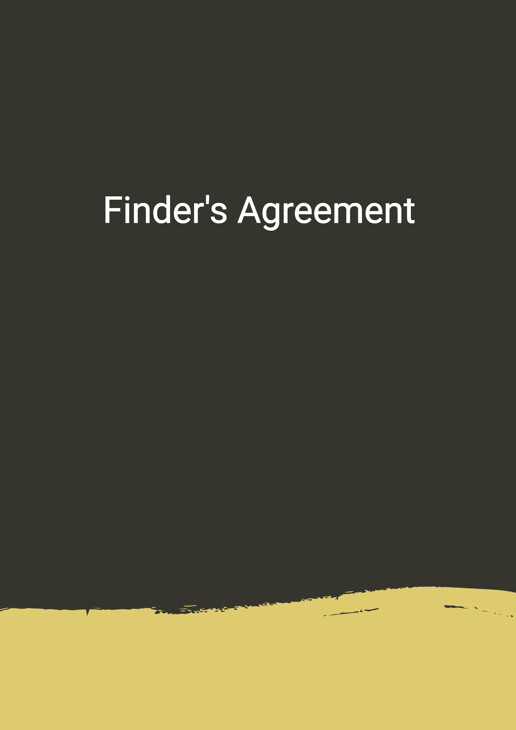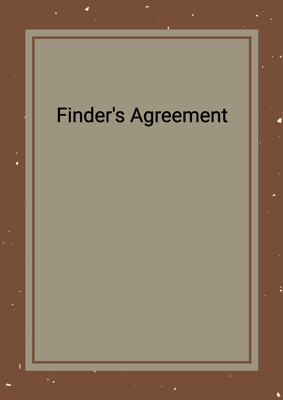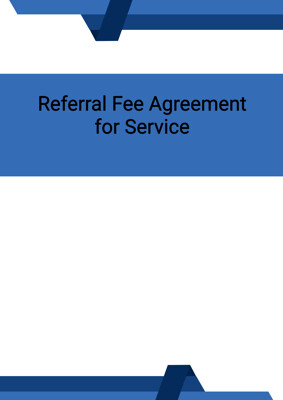How to Tailor the Document for Your Need?
01
Create Document
Fill in the details of the parties. You can click the "Fill with Member’s Information" button to complete it with information saved to your account.
02
Fill Information
Please fill in any additional information by following the step-by-step guide on the left hand side of the preview document and click the "Next" button.
03
Get Document
When you are done, click the "Get Document" button and you can download the document in Word or PDF format.
04
Review Document
Please get all parties to review the document carefully and make any final modifications to ensure that the details are correct before signing the document.
Document Preview
Document Description
The Finder's Agreement is a legally binding document that outlines the terms and conditions between two parties, namely the Principal and the Agent. The importance of this document lies in its ability to establish a clear understanding and agreement between the parties involved.
The entire document is divided into several sections, each serving a specific purpose. The first section, titled 'Interpretation', provides definitions for key terms used throughout the agreement. This ensures that both parties have a common understanding of the terminology used.
The second section, titled 'Services', outlines the scope of work to be performed by the Agent on behalf of the Principal. This section specifies that the Agent is engaged on an exclusive basis to source independent third-party purchasers or sellers for the entire sale interest. The duration of this engagement is defined as the 'Term'.
The third section, titled 'Excluded Persons', identifies certain individuals or entities that have already approached the Principal for a proposed acquisition or sale of the sale interest. These individuals or entities, along with their affiliates, are referred to as 'Excluded Persons'.
The fourth section, titled 'Agreed Person', establishes the requirement for a written confirmation to be signed by both parties before any introduction or meeting takes place between the Agent and a potential independent third party. This confirmation includes the full legal name, brief description, and accurate contact details of the agreed person.
The fifth section, titled 'Commission', outlines the commission structure for the Agent. If a qualified transaction is completed, the Agent is entitled to receive a commission based on the net premium from the Principal. The specific conditions for payment are detailed based on whether the Principal is a seller or a buyer.
The sixth section, titled 'Taxes', clarifies that each party is responsible for paying their own taxes arising from the transactions outlined in the agreement.
The seventh section, titled 'Confidentiality', imposes a duty on both parties to maintain the confidentiality of the agreement and its terms, except as required by applicable laws or court orders.
The eighth section, titled 'Nature of Agreement', addresses various aspects of the agreement, including the ability of the Principal to perform obligations through other companies, the assignment of rights and obligations, and the prohibition on sub-agents without written consent. It also clarifies that the agreement does not create a partnership or employer-employee relationship between the parties.
The ninth section, titled 'No Rights under Contracts for Third Parties', states that individuals or entities not party to the agreement have no right to enforce its terms.
The tenth section, titled 'Arbitration and Proper Law', establishes the jurisdiction and proper law governing any disputes arising from the agreement.
The eleventh section, titled 'Notices and Service', outlines the requirements for giving notice under the agreement, including the methods of delivery and the addresses of the parties. It also allows for changes to be notified in writing.
The agreement concludes with the signatures of the duly authorized representatives of both parties, along with a schedule listing the excluded persons and their affiliates.
How to use this document?
To effectively use the Finder's Agreement, follow these steps:
1. Understand the purpose: Familiarize yourself with the importance of the document, which is to establish a clear agreement between the Principal and the Agent.
2. Review the sections: Read through each section of the agreement, paying attention to the detailed descriptions and introductions provided for each section.
3. Interpretation: Take note of the definitions provided in the 'Interpretation' section to ensure a common understanding of key terms.
4. Services: Understand the scope of work outlined in the 'Services' section, which specifies the Agent's role in sourcing third-party purchasers or sellers.
5. Excluded Persons: Review the 'Excluded Persons' section to identify individuals or entities that have already approached the Principal for a proposed acquisition or sale.
6. Agreed Person: Familiarize yourself with the requirement for a written confirmation to be signed before any introduction or meeting takes place with a potential third party.
7. Commission: Understand the commission structure outlined in the 'Commission' section, including the conditions for payment based on whether the Principal is a seller or a buyer.
8. Taxes: Be aware of your responsibility to pay your own taxes arising from the transactions outlined in the agreement.
9. Confidentiality: Maintain the confidentiality of the agreement and its terms, except as required by applicable laws or court orders.
10. Nature of Agreement: Understand the various aspects of the agreement, including the ability to perform obligations through other companies and the prohibition on sub-agents without written consent.
11. No Rights under Contracts for Third Parties: Recognize that individuals or entities not party to the agreement have no right to enforce its terms.
12. Arbitration and Proper Law: Understand the jurisdiction and proper law governing any disputes arising from the agreement.
13. Notices and Service: Follow the requirements for giving notice under the agreement, including the methods of delivery and the addresses of the parties.
14. Signatures: Ensure that the agreement is signed by the duly authorized representatives of both parties.
15. Schedule: Review the schedule listing the excluded persons and their affiliates to be aware of any restrictions or limitations.
By following these steps, you can effectively use the Finder's Agreement and ensure a clear understanding and agreement between the Principal and the Agent.
Not the right document?
Don’t worry, we have thousands of documents for you to choose from:














